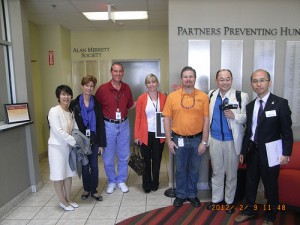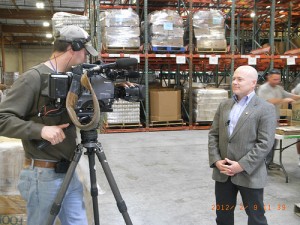From Feb 1 to 10, 2012, the world’s first food bank, St. Mary’s Food Bank Alliance, welcomed Food Bank Yamanashi, Second Harvest Japan, and Second Harvest Asia for a study tour in Phoenix, Arizona.
This tour was planned for Food Bank Yamanashi, a regional food bank in Yamanashi, Japan, to learn about the food bank’s hunger alleviation activities and its collaboration with the government sector.
Food Bank Yamanashi has been successful with working with the local government in Japan. In order to leverage the relationship and provide support in a wider range to hungry children at schools, they had great interests in St. Mary’s Kid’s Cafe. Besides that, Food Bank Yamanashi gained a great amount of information about SNAP (formerly known as Food Stamp), and other part of the food bank’s operations.
Food Bank Yamanashi’s Keiko Yoneyama says,
“I felt impressed by learning the active volunteerism in America, people’s participation in charitable donations, various volunteers being active at St. Mary’s, and the 11-million-dollar public support for the food bank.”
As an intermediary agent, Second Harvest Japan’s Charles McJilton says,
“We cannot say thank you enough for the generosity of St. Mary’s Food Bank Alliance. I had the honor of meeting John Van Hengel (the father of food banking) and was struck by his passion for food banking and his willingness to share his knowledge. While St. Mary’s has more than 45 years of experience and the scale of operations are dramatically different, we still find things we can take back to Japan. I credit this with two things: First, the staff retain John’s original spirit of generously sharing their knowledge. Everywhere we went people welcomed us and asked how they could serve us or what they could do for us. You do not always see this level of generosity. The second is we have developed a relationship with St. Mary’s and we understand their operations. This is what our organizations have to offer.This trip confirms the mission of Second Harvest Asia: Promoting food banking in Asia by acting as a bridge between food banks to share best practices. Had this been our first visit to St. Mary’s we would not have had the opportunity fully explain their operations in detail to the delegation from Yamanashi. But because we had had the opportunity to see many sides of St. Mary’s over our previous visits, we could put the information they were being given in a broader context they could understand from a Japanese perspective.To use a baseball metaphor, food banking in the US is Major League Baseball. The warehouses are magnificent stadiums, the staff are professionals, and there never seems to be a shortage of fans/volunteers. The food banks in Japan have simple playing fields with a few chairs, less than a handful make a living doing food banking, and there never seems to be enough room or work to accommodate volunteers. In this situation, it is easy to come to the US and be overwhelmed at both the physical size, but the depth of these food bank organizations. Your first thought is that we have nothing to talk about. Food banking is food banking and baseball is baseball no matter where you go in the world. But what happens ‘off the field’ does have a dramatic influence on how big the game can become and how many people can be served.We learned that if you are lucky to find a good partner like St. Mary’s, take the time to cultivate the relationship, and invest time in contextualizing their operations in relation to what is happening in one’s own country you can reap multitude of benefits. As anyone who speaks two or more languages knows, it is not merely changing one word into another language but rather interpreting the concepts into another culture. This is the strength of Second Harvest Asia: The ability to find ways food banks can share best practices and profit from their interaction to make their own organization stronger. This was the vision of John in 1986 when he incorporated the first international food bank association to promote food banking throughout the world. In 2007 the Global Foodbanking Network was established to continue this dream. We established Second Harvest Asia in 2010 to specifically address our needs in Asia. We thank St. Mary’s for continuing to share this spirit of food banking that was started there 45 years ago.The world is a better place for what you do. Food banking in Asia is stronger today for us having met yesterday. We look to tomorrow for future opportunities to share our strengths to continue to create a world where no one has to go to bed hungry.”
While McJilton was in Phoenix, he was interviewed by a local news channel about Second Harvest Japan’s disaster relief.
Second Harvest Asia is happy with the fact that we were able to connect the two organizations from the two countries. Even though the cultural backgrounds of the nonprofit sectors are different, still Food Bank Yamanashi found there were a lot they could apply to Japan. The representatives of Food Bank Yamanashi were deeply touched by St. Mary’s staff’s warm welcome.
On this website, we will post the detailed report from Food Bank Yamanashi about the tour soon. We hope the report will help other food bank organizations learn about the state-of-the-art operations of St. Mary’s.
We sincerely thank St. Mary’s Food Bank Alliance’s generosity.
Second Harvest Asia will develop the regional food bank network in Asia to share best practices and experiences with other food banks. We hold online meetings regularly with Asian food bank members. If you are interested in joining our regional network, please contact us at info@secondharvestasia.org.


